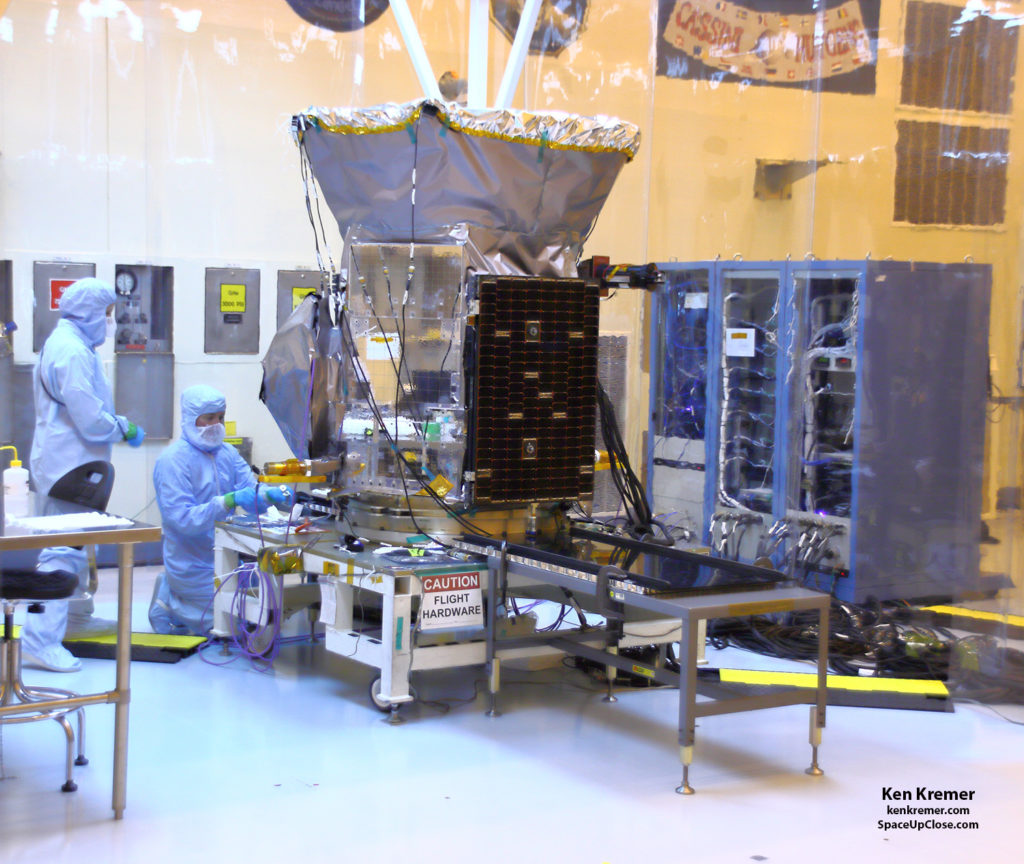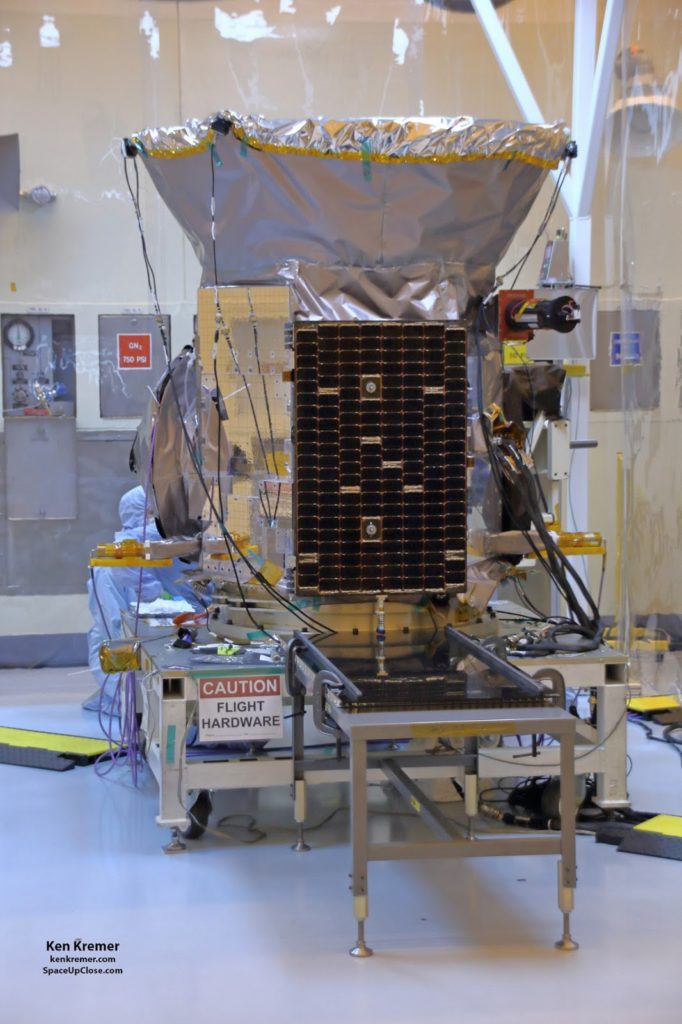Transiting Exoplanet Survey Satellite (TESS) who’s
goal is to search for new Earth’s that could potentially support life is on
target to launch April 16 from the Florida Space Coast.
will help answer the biggest question of them all – ‘Are We Alone in the Universe?’
is scheduled to blast off on a SpaceX Falcon 9 rocket at 6:32 p.m. EDT Monday,
April 16 from Space Launch Complex-40 on Cape Canaveral Air Force Station.
launch window lasts only a very short 30 seconds.
close look and media briefing about the small sized but scientifically powerful
observatory during a visit with the spacecraft and team inside the clean room
processing facility at the Payload Hazardous Servicing Facility
clean room at NASA’s Kennedy Space Center.
photos.
and discovering new Earth and Super Earth sized planets beyond our Solar System
that orbit their host stars inside the habitable zones that offer conditions conducive
to the origin and evolution of life.
mission, TESS will gradually sweep across the entire sky and conduct a full sky
survey by monitoring and investigating over 200,000 of the nearest and brightest stars to
search for planets outside our solar system.
astronomer finds a planet in a star’s habitable
zone, will it be interesting from a
biologist’s point of view?” said George Ricker, TESS principal investigator at
the Massachusetts Institute of Technology (MIT) Kavli Institute for
Astrophysics and Space Research in Cambridge, which is leading the mission.
atmospheric compositions, which hold potential clues to the presence of life,
could be precisely measured by future observers.”
mission and a follow up to the hugely successful Kepler probe which discovered
over 2300 exoplanets of all sizes.
spacecraft is equipped with 4 identical wide-field science cameras. Their combined field of view will enable the
spacecraft to image some 85% of the entire sky during the full sky survey over
the first two years.
gathered by TESS hope to discover on the order of 300 to 500 Earths and Super
Earths alone, orbiting in their habitable zones compared to a dozen or so by Kepler.
orbits and sizes of these exoplanets.
They will also provide the specific targets for follow up high
resolution investigations by NASA’s James Webb Space Telescope and other
telescopes to determine the exoplanets masses, compositions and atmospheric
constituents.
to determine if any of the newly discovered Earths and Super earths and
actually Earth like possessing water, oxygen and carbon based molecules for
example that can potentially support life.
survey? The sky has been subdivided into 26 observing sectors that basically
equate to tileing the sky piece by piece – much like covering your kitchen
floor with tiles.
time by pointing the four cameras to discrete sectors of the sky and then
combining them into an overarching panorama of the Universe encircling Earth.
hemispheres – southern and northern.
into 13 sectors that will be observed one by one. The southern sky of 13 sectors will be imaged
initially over the first year, followed by the northern sky of 13 sectors over
the second year.
four 16.8 megapixel CCD’s and a seven element optical system.
of the spacecraft inside a protective sunshade to shield the instruments.
for approximately 28 days of continuous observations.
24 degrees by 24 degrees. The 4 cameras combine to simultaneously cover a
sector of 24 x 96 degrees.
launched by SpaceX for NASA.
TESS to a highly elliptical Earth orbit never used before by a science mission, Ricker said
at the media briefing.
in a 2:1 resonance orbit with the moon. The moon orbits earth every 28 days.
as a result, thus requiring minimal fuel to maintain. The spacecraft is loaded with enough propellants to continue its observations
for 20 years if all goes well with the spacecraft systems.
Stephen Rinehart, TESS project scientist at NASA’s Goddard Space Flight Center
in Greenbelt, Maryland, which manages the mission. “We’re going to be able study
individual planets and start talking about the differences between planets. The
targets TESS finds are going to be fantastic subjects for research for decades
to come. It’s the beginning of a new era of exoplanet research.”
The $240 million spacecraft was
built by prime contractor Orbital ATK.
770 pounds (350 g) and measures 12 x 4 x 5 ft (3.7 x 1.2 x 1.5 m).
George Ricker, of MIT’s Kavli Institute for Astrophysics and Space Research,
serves as principal investigator for the mission. TESS’s four wide-field
cameras were developed by MIT’s Lincoln Laboratory. Additional partners include
Orbital ATK, NASA’s Ames Research Center, the Harvard-Smithsonian Center for
Astrophysics, and the Space Telescope Science Institute. More than a dozen
universities, research institutes and observatories worldwide are participants in the mission.
SpaceX, ULA, Boeing, Lockheed Martin, Orbital ATK and more space and mission
reports direct from the Kennedy Space Center and Cape Canaveral Air Force
Station, Florida.
Earth and Planetary science and human spaceflight news: www.kenkremer.com –www.spaceupclose.com –
twitter @ken_kremer – ken
at kenkremer.com








